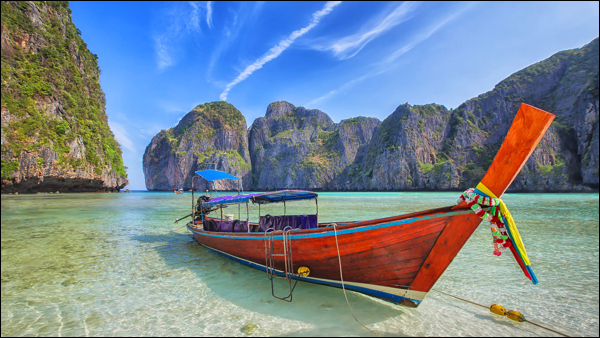Ko Phi Phi Leh is the second largest island of the archipelago, the largest being Ko Phi Phi Don. The island consists of a ring of steep limestone hills surrounding a shallow bay; Maya Bay.
The national park, known as Hat Nopparat Thara-Mu Koh Phi Phi National Park, is the 46th national park of Thailand and covers 387.90 km². it stretches from the Thai mainland at Nopparat Thara Beach in Krabi, to the islands of Phi Phi, which are easy to reach by regular ferry from both Phuket and Krabi.

Having fun at Ko Phi Phi Leh.
Geography
In north -east of the Island you can find the Wai-King-Cave (also: Viking Cave). Inside you can find historic mural paintings which show boats and elephants.
The park's islands and the coastal hills are composed mainly of limestone and are an extension of the mountain range running down from Phang-Nga Province. The main characteristics of these mountains and islands are their steep cliffs, large caves and dwarf trees that grow out of their rock crevice homes, similar to those of Phang-Nga Bay. The geology of this area is characterised by high, vertical limestone karsts (hollow, upright cylindrical islets), jutting from the sea in a northwest-southeast direction.
The first important geology happened 300 million years ago when South East Asia was the largest coral reef in history. Obviously formed under the sea, the crescent-shaped reef ran from Bali and Borneo north off Australia and drifted past Thailand, creating incredible pressures that rippled the landscape into giant ridges running North and South.
Limestone Karst
Limestone is almost 20% of the Earth's surface, but it only forms bizarre and grotesque formations in areas of heavy rainfall. There is karst in the Balkans, but most karst is at least tropical or Equatorial (like Phuket at Latitude 8), where heavy rains create jagged surfaces and honeycomb caverns. Originally coral, the hard and brittle karst is "porous".
With its origins in coral, limestone is brittle. You see countless cracks or faults in the rock created by pressure. When large faults slip, the limestone breaks off in blocks, often big enough to become these islands. Imagine huge limestone blocks floating on the Earth's crust like a cube of ice floating in a glass of water. When continental plates drift, the limestone spins and bobs up and down just like ice does when you put your finger on the cubes. These cracks collect oxide before the rock rotates again, taking the iron ore high above sea level. Some cave roofs have holes leading to either sunlight or another cave, the earliest point of Hong creation. Eventually, the cavern will collapse, one way of forming a "Hong", which is Thai for chamber or room. The overhang is created by tidal erosion. Often made by wave action as well, this notch is called the "Nape".

Ko Phi Phi Leh as seen from above.
The Beach (movie)
Released in 2000 by Danny Boyle, cult film The Beach reveals a dream cast; actors Guillaume Canet, Leonardo DiCaprio, Virginie Ledoyen and Tilda Swinton make us live their surprising adventures.
Controversy arose during the making of the film. 20th Century Fox allegedly bulldozed and re-scaped the natural beach setting of Ko Phi Phi Leh to make it more "paradise-like", altering sand dunes and clearing vegetation to widen the beach. A fund was set aside to reconstruct and return the beach to its natural state; however, lawsuits were filed as many believed the restoration attempts failed and the damage to the ecosystem is permanent.
The lawsuits dragged on for years. In 2006, Thailand's Supreme Court upheld an appeal court ruling that the filming had harmed the environment and ordered that damage assessments be made. Defendants in the case included 20th Century Fox and Thai government officials.

The Beach featuring Leonardo Di Caprio.
Tourism
After the film, Ko Phi Phi Leh and Maya Beach in particular witnessed a steep influx of tourists.
Many Thai marine national parks are closed from mid-May to mid-October, but because of tourist demand, Maya Bay has remained open year-round since the film The Beach. Tourism went largely unchecked, and on average Maya Beach would receive 200 boats and 4,000 visitors each day!
The daily hordes of tourists had a huge impact and exhausted the island's eco system. Surveys by a team led by marine biologists found a large part of the coral reefs around the area were gone and sea life had virtually disappeared. Drastic measures were taken, and June 2018, it was decided by Thailand's National Parks and Wildlife Department to restrict access for 4 months to allow for the recovery of the battered coral reefs and sea life. However, environmentalists and researchers deemed the period insufficient and in October 2018, the restriction was extended for at least another year.
Managing tourist destinations and the development of sustainable tourism has become an urgent matter. More than 35 million tourists visited Thailand last year, compared to around 10 million when The Beach premiered in 2000.
Thai authorities have in the past closed off islands ruined by mass tourism. Koh Yoong, also part of the Phi Phi island chain, and Koh Tachai, in the Similan Islands National Park, have been off limits to tourists permanently since mid-2016. Both islands have since recovered and the results have been amazing. Areas with a bleak sea life environment and coral bleaching are now teeming with robust and colorful sea life and coral.
When Maya Bay (officially) reopens, the department will likely set a daily limit of 2,000 tourists, while boats will no longer be allowed into the bay and will have to dock on the opposite side of the island.
What you need to know!
Access to Ko Phi Phi Leh is currently heavily restricted but not forbidden. Sporadically, visitors are allowed to support the local population and to avoid a total collapse of the tourism industry. As a result, a visit to the beach might not always be possible. Thankfully the questions are easy, and the answers can easily be retrieved from the internet if need be.
Updated access rules (15 November, 2021) are mentioned in an Owner Maintenance log.

Longtail boat at Koh Phi Phi Leh.
How to claim this EarthCache?
Send me the following;
1. On the first line of your message, write "GC24XKT Koh Phi Phi Leh".
2. The answers to the following questions;
- Which protection unit serves Maya Bay?
- What kind of geological characteristic can be seen in the Viking-Cave?
- How long is the Viking-cave?
3. Provide a photo of yourself or a personal item to prove you have visited the site. *
References
* Effective immediately from 10 June 2019, photo requirements are permitted on EarthCaches. This task is not optional, it is an addition to existing logging tasks! Logs that do not meet all requirements posed will no longer be accepted.
For additional information, visit; Geosociety.org, Geocaching.com Help Center and Geocaching.com Forum.
Finding the answers to an EarthCache can often be challenging, and many people tend to shy away from these caches because of this. However, it is my opinion that geocaching is also meant to be a fun family experience that simply aims to introduce interesting and unique locations such as this one. Flexibility on logging requirements, however, can only be applied if it can be established that you have actually taken the time to visit the site. For this reason, a proper log describing your adventure accompanied by a good number of photos would be much appreciated.